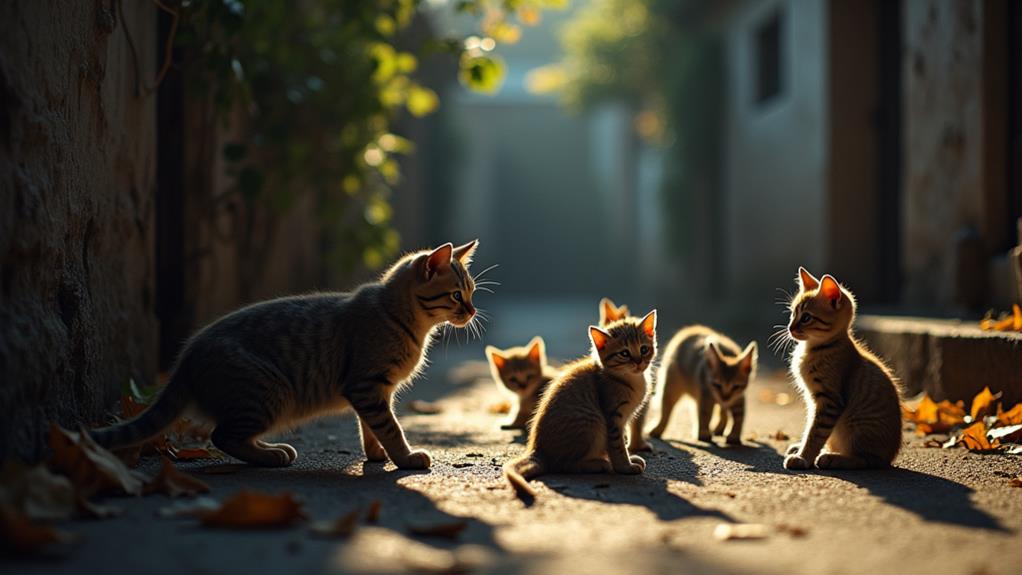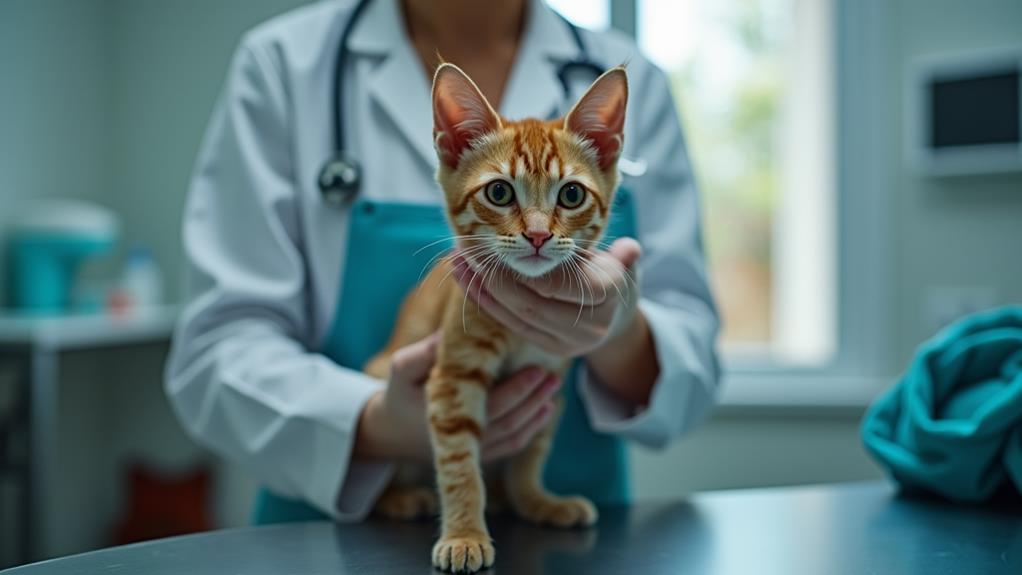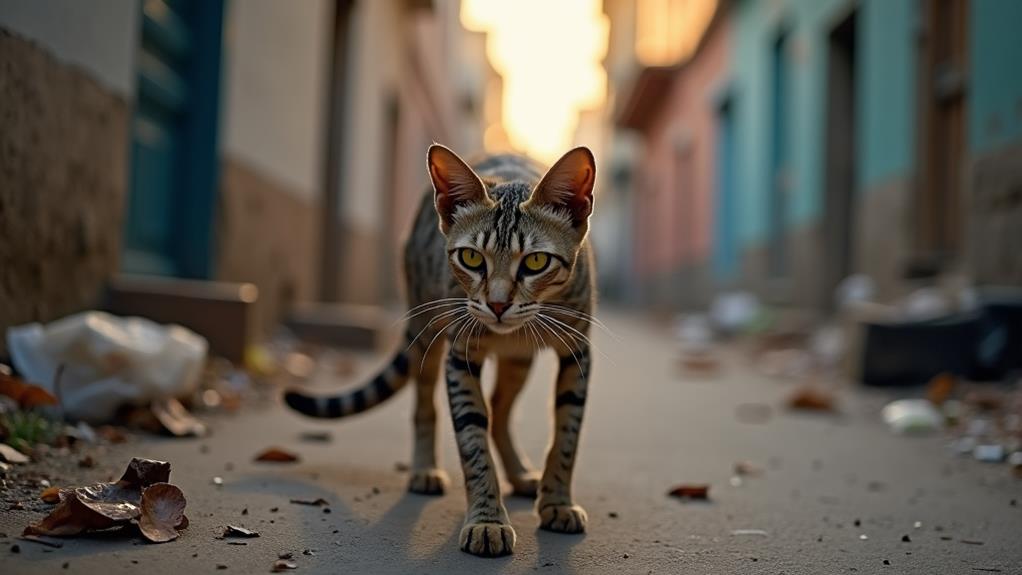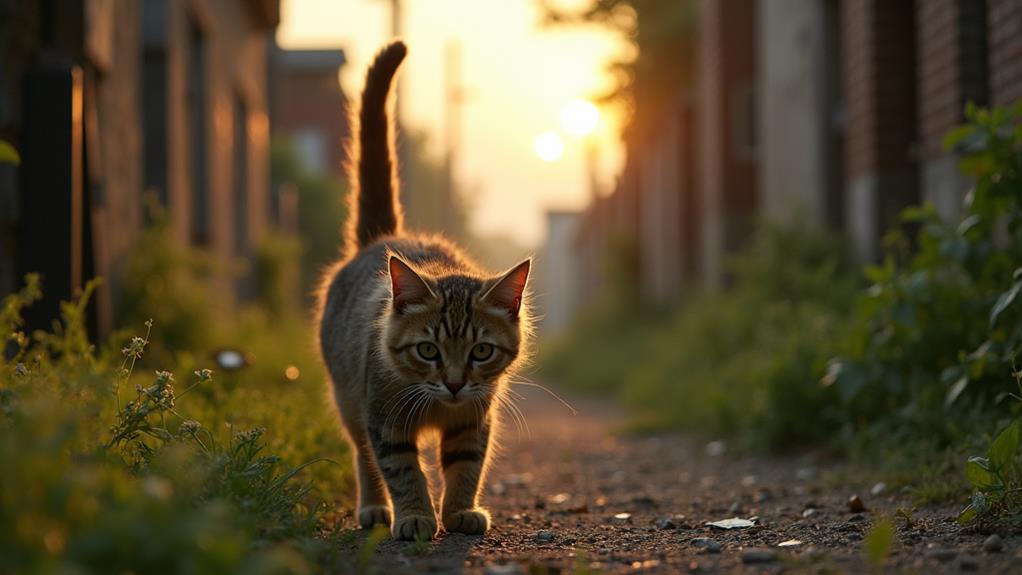How Many Litters Can a Feral Cat Have in a Year? Feral Cat Reproduction Explained

A feral cat can have 2-3 litters each year, beginning as early as 4-5 months old. Each litter typically includes 3-5 kittens. This rapid reproduction can lead to a single female producing around 200 kittens in her lifetime if she's not spayed. Such prolific breeding results in significant overpopulation problems, affecting wildlife and public health. Feral kittens face bleak survival odds, with about 75% not making it past six months. Understanding these dynamics is essential for effective population control and maintaining balanced ecosystems. Exploring interventions like TNR programs can provide insight on managing these resilient colonies successfully.
Understanding Feral Cat Behavior
Feral cats are enigmatic creatures that thrive in the shadows of human society. They're unsocialized, often avoiding human contact, which makes them quite different from your average outdoor cat. Instead of warm interactions with people, feral cats exhibit fascinating social behaviors within their colonies, often forming tight-knit groups around food sources. These cats, especially a feral female cat, become essential in the reproduction cycle, contributing to the colony's growth.
You might be surprised to learn that feral cats can reproduce as young as 4-5 months old. This early start in reproduction allows them to have multiple litters each year. On average, a feral female cat can produce 2-3 litters annually, each with about 3-5 feral kittens. This rapid multiplication results in significant population increases, especially if reproduction isn't managed.
Feral kittens born into these colonies quickly learn to navigate their environment, inheriting the wariness of their mothers. While these outdoor cats are resilient, their average lifespan is much shorter than their indoor counterparts. The lack of healthcare and constant dangers they face in the wild contribute to their brief lives. Understanding these behaviors is fundamental for effective population control and management.
Differences Between Feral and Stray Cats
While exploring the unique behaviors of feral cats, it's important to distinguish them from stray cats, as the two are often confused. Understanding these differences is vital, as misidentifying one for the other can lead to ineffective management strategies.
- Socialization: Feral cats are not socialized to humans and typically avoid human contact. In contrast, stray cats are former pets that can often be re-socialized and are usually more comfortable around people.
- Adoptability: Feral cats generally remain unadoptable due to their lack of human socialization and often have a high euthanasia rate in shelters. Stray cats, however, can be adoptable and may be successfully captured and returned to a home.
- Behavior: Stray cats might approach humans for help and display friendly behaviors. Feral cats, on the other hand, are more likely to be fearful and retreat if someone approaches them.
- Living Conditions: Feral cats live in colonies, typically around food sources, while stray cats may wander individually in search of food and shelter.
Recognizing these distinctions aids in implementing appropriate management strategies, ensuring the well-being and proper treatment of both feral and stray cat populations.
Feral Cat Reproduction Cycle

Although often overlooked, understanding the feral cat reproduction cycle is vital for effective population management. Feral cats can become pregnant as young as 4-5 months old, which accelerates the growth of feral populations. When a feral cat reproduces, it can produce 2-3 litters each year, resulting in an astonishing 20-30 kittens annually. With such prolific breeding, the population of feral cats can quickly spiral out of control without intervention.
The breeding season for feral cats typically peaks in the spring. During this time, female cats are most likely to become pregnant, with litters arriving from March to September. Sadly, about 75% of feral kittens don't survive past six months due to challenges like predation, disease, and food scarcity. This high mortality rate, however, doesn't greatly curb population growth due to the sheer number of kittens born.
To manage these burgeoning populations, TNR (Trap-Neuter-Return) programs play an important role. By trapping feral cats, neutering them, and returning them to their environment, you can prevent the cycle of reproduction and reduce the number of litters born annually. Understanding and acting on this cycle is key to controlling feral cat populations effectively.
Litter Frequency in Feral Cats
Typically, female feral cats have 2-3 litters each year, a frequency that greatly influences population dynamics. This high litter frequency is tied to several factors, including environmental conditions and resource availability. Feral cats can become pregnant as early as 4-5 months old, which means they start contributing to population growth quite rapidly. Each litter usually contains 3-5 kittens, potentially adding 20-30 new feral cats annually per female.
Considering these facts, the high reproductive rate of feral cats necessitates effective population management strategies. Here's why:
- Early Maturity: Feral cats become pregnant at a very young stage, accelerating population growth.
- Multiple Litters: With 2-3 litters each year, numbers can skyrocket without intervention.
- Large Litter Sizes: Each litter can considerably increase the population, creating challenges for communities.
- Lifetime Contribution: If not spayed or neutered, a single female can produce around 200 kittens over her lifetime.
To manage populations, spaying or neutering programs play an essential role in controlling the feral cat numbers. By addressing the litter frequency, these programs help maintain ecological balance and prevent overpopulation.
Impact of Overpopulation

Feral cat overpopulation greatly impacts communities and ecosystems alike. With feral cat populations expanding rapidly, unchecked growth leads to significant challenges. A single female cat can produce up to 200 kittens in her lifetime, which contributes to the escalating number of feral cats. These growing populations often consist of colonies with 10-20 individuals, and without intervention, they can increase by 20-30% annually. This overpopulation directly affects the welfare of homeless cats and creates a strain on resources.
Animal shelters face overwhelming pressure due to the sheer number of feral cats. As a result, euthanasia rates rise, with around 25,000 healthy cats euthanized daily simply because there aren't enough homes. This grim reality highlights the urgent need for effective solutions to manage feral cat populations. Implementing spay/neuter programs can help control the birth rate, reducing the number of homeless cats entering the system.
Moreover, overpopulation affects the quality of life for both cats and humans. Crowded feral colonies can lead to increased disease transmission among cats, while communities experience the negative impacts on local wildlife and public health. Addressing overpopulation through humane methods like trap-neuter-return is crucial for balancing ecosystems and improving conditions for all.
Trap-Neuter-Return (TNR) Overview
Trap-Neuter-Return (TNR) is a widely recognized and humane strategy for controlling feral cat populations. It involves trapping the cats, spaying or neutering them, vaccinating, and then returning them to their original habitat. This humane approach not only helps in reducing the population over time but also improves the reproductive health and general well-being of the feral colonies. By preventing uncontrolled breeding, TNR programs guarantee that feral cat populations don't grow exponentially.
TNR programs offer several benefits:
- Population Control: By spaying or neutering cats, you effectively reduce the population growth, making colonies more manageable.
- Improved Health: Cats that undergo TNR are generally healthier as they avoid the stresses of constant breeding.
- Behavioral Changes: After TNR, cats are less likely to engage in nuisance behaviors like howling and spraying, which makes them better neighbors.
- Community Involvement: Many animal welfare organizations provide low-cost or free services, encouraging community participation in managing feral cat populations.
Eartipping Significance

In discussing the thorough approach to managing feral cat populations, it's imperative to highlight the significance of eartipping within the Trap-Neuter-Return (TNR) framework. Eartipping involves removing the tip of a feral cat's left ear while the cat is under anesthesia. This simple practice serves as a clear visual indicator that a feral cat has been spayed or neutered. By doing so, caregivers and veterinarians can effortlessly identify these cats from a distance, avoiding unnecessary trapping and surgical procedures.
Eartipping is not only an effective tool for population management but also essential for the success of TNR programs. It helps stabilize feral cat populations by ensuring only unaltered cats are targeted for trapping. This efficient use of resources directly contributes to the improved health and well-being of the feral cat community. Significantly, the eartipping process is painless for the cats and doesn't affect their ability to hear, hunt, or interact with their environment.
Ultimately, eartipping plays a critical role in effective feral cat management. It facilitates monitoring the success of TNR efforts, ensuring that resources are allocated efficiently and that the comprehensive feral cat population is controlled and healthy.
Resources for Feral Cat Management
Managing feral cat populations effectively requires a range of resources and support systems. Community organizations like Alley Cat Allies and Devine Feline play significant roles in feral cat management by providing advocacy and resources for Trap-Neuter-Return (TNR) programs. TNR reduces overpopulation by offering low-cost spaying/neutering and vaccination services, ensuring that feral cats are healthy and unable to reproduce.
To support TNR efforts, you can rely on several resources:
- Community Organizations: These groups offer guidance and support for TNR initiatives, helping educate the public about the benefits of spaying/neutering feral cats.
- Pet Food Pantries and Shelters: They provide fundamental food sources and supplies, which are important for sustaining feral cat colonies and facilitating TNR programs.
- Local Guidelines and Legal Considerations: Understanding legal aspects can improve humane feral cat management, ensuring compliance with local regulations and promoting TNR as a viable solution.
- Animal Control: Partnering with Animal Control can strengthen TNR efforts by integrating their resources and expertise into community programs.
Community involvement is key to successful feral cat management. By fostering awareness and education, you help create a sustainable environment for managing feral cat populations.
Health Implications of Spaying

While efforts to manage feral cat populations through TNR programs are fundamental, addressing the health implications of spaying is likewise important. Spaying plays a key role in maintaining the well-being of feral cats by preventing the rapid population growth that comes with multiple litters each year. Unaltered female feral cats can have 2-3 litters annually, which can lead to numerous health issues and complications during pregnancy and birth.
By opting for spaying, you greatly reduce the risks associated with pregnancy-related complications, both for the mother and her kittens. It's worth noting that about 75% of feral kittens don't survive past six months due to health risks, so spaying helps decrease the number of unwanted and vulnerable kittens. Additionally, experienced veterinarians consider spaying during early to mid-pregnancy safe, helping to prevent these complications.
Along with controlling population growth, spaying reduces the incidence of certain health issues like mammary tumors and pyometra in feral cats. This procedure not only prevents unnecessary suffering but also improves the general well-being of the feral cat population. As a result, spaying is an important health consideration for managing feral cat colonies effectively.
Strategies for Population Control
Addressing feral cat overpopulation requires strategic and effective measures. Feral cats can produce multiple litters annually, quickly leading to an overwhelming population if left unchecked. One highly effective strategy is the Trap-Neuter-Return (TNR) program. By trapping feral cats and spaying/neutering them, you can greatly reduce the number of unwanted pregnancies and litters. This approach not only curtails the reproductive cycle but also stabilizes the feral cat population over time.
To efficiently implement population control, consider these key strategies:
- Trap-Neuter-Return (TNR) Programs: Capture feral cats, sterilize them, and return them to their original locations. This is a humane way to prevent rapid population growth.
- Spaying/Neutering: Guarantee that spaying/neutering services are accessible and affordable to the community. This reduces the number of litters and unwanted kittens.
- Community Engagement: Educate and involve community members. When everyone understands the importance of population control, they're more likely to participate in TNR efforts.
- Monitoring the Reproductive Cycle: Focus on peak breeding times, especially in spring, to improve the effectiveness of TNR and reduce the impact of feral cats.




